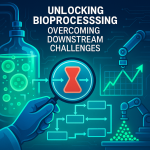📉 High titres can mislead productivity measures as they don’t reflect downstream processing losses.
🔧 An integrated approach optimizes both production and purification, enhancing net yields and reducing costs.
🌐 Techniques like QTL technology can improve bioprocessing efficiency, making it commercially viable and sustainable for the future.
Introduction:
The article focuses on the significance of net titre as a critical metric for assessing productivity in bioprocessing. As the demand for high-quality bioproducts increases, understanding net titre, which reflects the yield after accounting for losses during downstream processing, becomes essential for optimizing biomanufacturing processes.
- Net titre is defined as the effective yield after downstream processing losses are deducted, emphasizing its importance over gross titres for productivity measurement.
- High titres can be misleading since they do not reflect losses incurred during downstream processing, which can significantly affect profitability.
- Traditional bioprocessing often prioritizes high titres but tends to neglect efficiency due to material losses during purification.
- An integrated approach that optimizes both upstream and downstream processes can maximize net titre and ensure commercial viability.
- Recent advancements and case studies indicate that employing QTL technology and synthetic biology to enhance metabolic pathways can lead to higher yields and reduced production costs.
Conclusion:
The integration of upstream and downstream processing is critical to achieving sustainable and cost-effective bioproduction strategies. By focusing on optimizing net titre through innovative techniques, the bioprocessing industry can enhance the overall efficiency and effectiveness of biomanufacturing, thereby meeting the growing demands for high-quality bioproducts.



